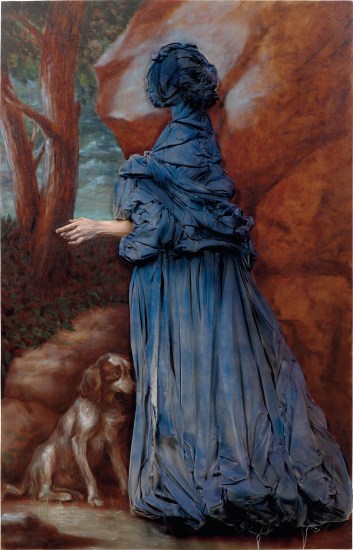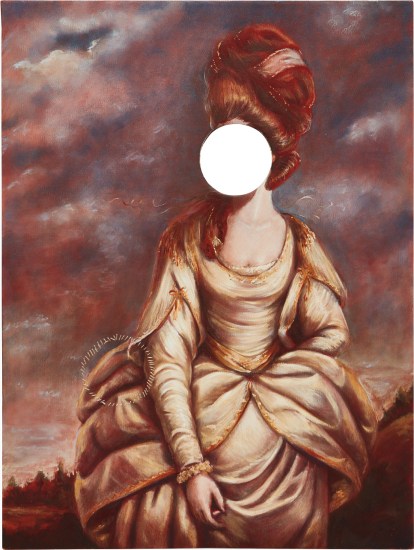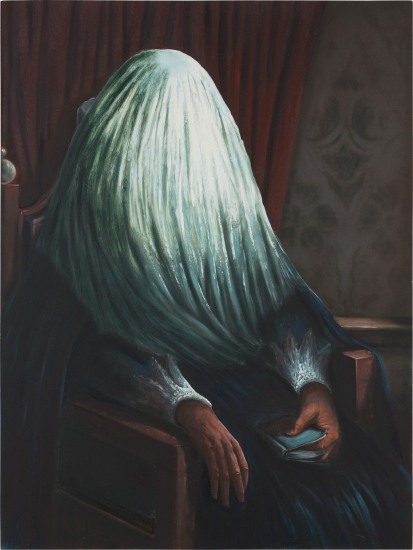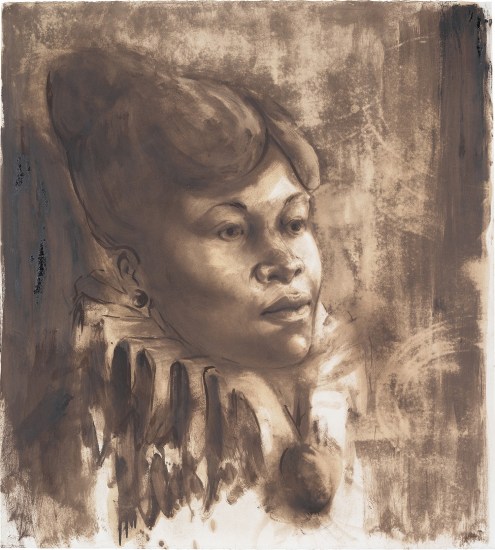4Titus KapharAlternate Endingssigned and dated 'Kaphar 16' on the reverse oil on canvas mounted on panel 199 x 121.9 cm (78 3/8 x 47 7/8 in.) Painted in 2016. Full CataloguingEstimate £60,000 - 80,000 ‡ Place Advance BidContact Specialist Kate Bryan Specialist, Head of Evening Sale +44 20 7318 4026 kbryan@phillips.com
Overview'I was so focused on art history because so much of what was being told to me —'the canon'— had so many glaring absences that were very loud to me. So my work, from the beginning, really looked at those absences.' —Titus Kaphar Depicting a black man standing next to the silhouette of a seated other, Alternate Endings is a magnificent painterly manifestation of Titus Kaphar’s diverse oeuvre, focusing on the long-overlooked presence (or absence) of black figures in the Western canon. The image, drenched in meandering cobalt blues, reveals Kaphar’s idiosyncratic portrayal of presence and absence, whereby what is shown is as essential as what is concealed. Fully discernible to the viewer in comparison to his meekly delineated counterpart, the protagonist in the composition wears an attire that is suggestive of a servant’s uniform in 16th century Netherlands, thereby addressing themes of dislocation, colonialism, and thorny Western legacies. Having come into the limelight soon after Time magazine commissioned him in 2014 to make a painting for one of its ‘Person of the Year’ finalists, Kaphar has since accumulated an impressive array of solo presentations, including, most recently, a highly acclaimed exhibition at the Brooklyn Museum, New York, in 2019. Having taught himself how to paint by going to museums and studying historical paintings, Kaphar has been known to utilise visual strategies employed by European classicists – Rembrandt, Pierre-Auguste Renoir Edouard Manet – to rewrite antiquated narratives of cultural empowerment. Specifically, he has mentioned the importance of Frans Hals’ iconic sense of composition in his oeuvre, which focuses on preeminent, wealthy white subjects, with the occasional timid inclusion of a black servant. However, ‘It becomes quite obvious’, he remarks, ‘that if I'm going to learn how to paint a self-portrait by studying those [classicists], I'm going to be challenged when it comes to mixing my skin or mixing the skin of those people in my family. There's literally formulas written down historically to tell me how to paint white skin -- what colors I should use for the underpainting, what colors I should use for the impasto highlights. That doesn't really exist for dark skin’.i Blurring out the physical specificities of certain subjects to highlight the presence of frequently omitted others thus not only became Kaphar’s trademark strategy to enable Black visibility; it furthermore became a tool to challenge traditional readings of a picture. 'The only real thing that exists in the painting is the absence, the hole.' —Titus KapharThrough distinct methodologies of shredding, overpainting, and erasing both subject and support, Kaphar has, since graduating from his MFA at Yale University in 2006, built new artistic formulas apprehending Black visibility in figurative art. In Alternate Endings, the obscuring of the seated figure to the left of the composition not only serves as a self-referential element tied to Kaphar’s eclectic practice -- in which he literally cuts human-shaped silhouettes from large paintings and installations -- but also points to the systemic erasure of Black experience from historical narratives. In other words, the two characters in the composition -- one hidden and one almost palpable in verisimilitude -- together account for the diminished or dislodged identities that were either produced or deliberately forgotten by colonialist legacies for centuries. Indeed, Kaphar utilises both realism and abstraction ‘to either emphasise their absence or to get you to focus on the other folks in the composition’.ii The painting process itself, alternating between unfilled contours and complete objects and figures, becomes the embodiment of the ongoing struggle for visibility, while the saturated, artificial coloration running over the expanse of the composition adds further tension to the iconographic battle between what is there and what is not. Titus Kaphar in His Studio i Titu
4Titus KapharAlternate Endingssigned and dated 'Kaphar 16' on the reverse oil on canvas mounted on panel 199 x 121.9 cm (78 3/8 x 47 7/8 in.) Painted in 2016. Full CataloguingEstimate £60,000 - 80,000 ‡ Place Advance BidContact Specialist Kate Bryan Specialist, Head of Evening Sale +44 20 7318 4026 kbryan@phillips.com
Overview'I was so focused on art history because so much of what was being told to me —'the canon'— had so many glaring absences that were very loud to me. So my work, from the beginning, really looked at those absences.' —Titus Kaphar Depicting a black man standing next to the silhouette of a seated other, Alternate Endings is a magnificent painterly manifestation of Titus Kaphar’s diverse oeuvre, focusing on the long-overlooked presence (or absence) of black figures in the Western canon. The image, drenched in meandering cobalt blues, reveals Kaphar’s idiosyncratic portrayal of presence and absence, whereby what is shown is as essential as what is concealed. Fully discernible to the viewer in comparison to his meekly delineated counterpart, the protagonist in the composition wears an attire that is suggestive of a servant’s uniform in 16th century Netherlands, thereby addressing themes of dislocation, colonialism, and thorny Western legacies. Having come into the limelight soon after Time magazine commissioned him in 2014 to make a painting for one of its ‘Person of the Year’ finalists, Kaphar has since accumulated an impressive array of solo presentations, including, most recently, a highly acclaimed exhibition at the Brooklyn Museum, New York, in 2019. Having taught himself how to paint by going to museums and studying historical paintings, Kaphar has been known to utilise visual strategies employed by European classicists – Rembrandt, Pierre-Auguste Renoir Edouard Manet – to rewrite antiquated narratives of cultural empowerment. Specifically, he has mentioned the importance of Frans Hals’ iconic sense of composition in his oeuvre, which focuses on preeminent, wealthy white subjects, with the occasional timid inclusion of a black servant. However, ‘It becomes quite obvious’, he remarks, ‘that if I'm going to learn how to paint a self-portrait by studying those [classicists], I'm going to be challenged when it comes to mixing my skin or mixing the skin of those people in my family. There's literally formulas written down historically to tell me how to paint white skin -- what colors I should use for the underpainting, what colors I should use for the impasto highlights. That doesn't really exist for dark skin’.i Blurring out the physical specificities of certain subjects to highlight the presence of frequently omitted others thus not only became Kaphar’s trademark strategy to enable Black visibility; it furthermore became a tool to challenge traditional readings of a picture. 'The only real thing that exists in the painting is the absence, the hole.' —Titus KapharThrough distinct methodologies of shredding, overpainting, and erasing both subject and support, Kaphar has, since graduating from his MFA at Yale University in 2006, built new artistic formulas apprehending Black visibility in figurative art. In Alternate Endings, the obscuring of the seated figure to the left of the composition not only serves as a self-referential element tied to Kaphar’s eclectic practice -- in which he literally cuts human-shaped silhouettes from large paintings and installations -- but also points to the systemic erasure of Black experience from historical narratives. In other words, the two characters in the composition -- one hidden and one almost palpable in verisimilitude -- together account for the diminished or dislodged identities that were either produced or deliberately forgotten by colonialist legacies for centuries. Indeed, Kaphar utilises both realism and abstraction ‘to either emphasise their absence or to get you to focus on the other folks in the composition’.ii The painting process itself, alternating between unfilled contours and complete objects and figures, becomes the embodiment of the ongoing struggle for visibility, while the saturated, artificial coloration running over the expanse of the composition adds further tension to the iconographic battle between what is there and what is not. Titus Kaphar in His Studio i Titu



.jpg?w=400?width=1600&quality=70)
.jpg)

.jpg)
.jpg)



.jpg)
.jpg)
.jpg)
.jpg)
Try LotSearch and its premium features for 7 days - without any costs!
Be notified automatically about new items in upcoming auctions.
Create an alert